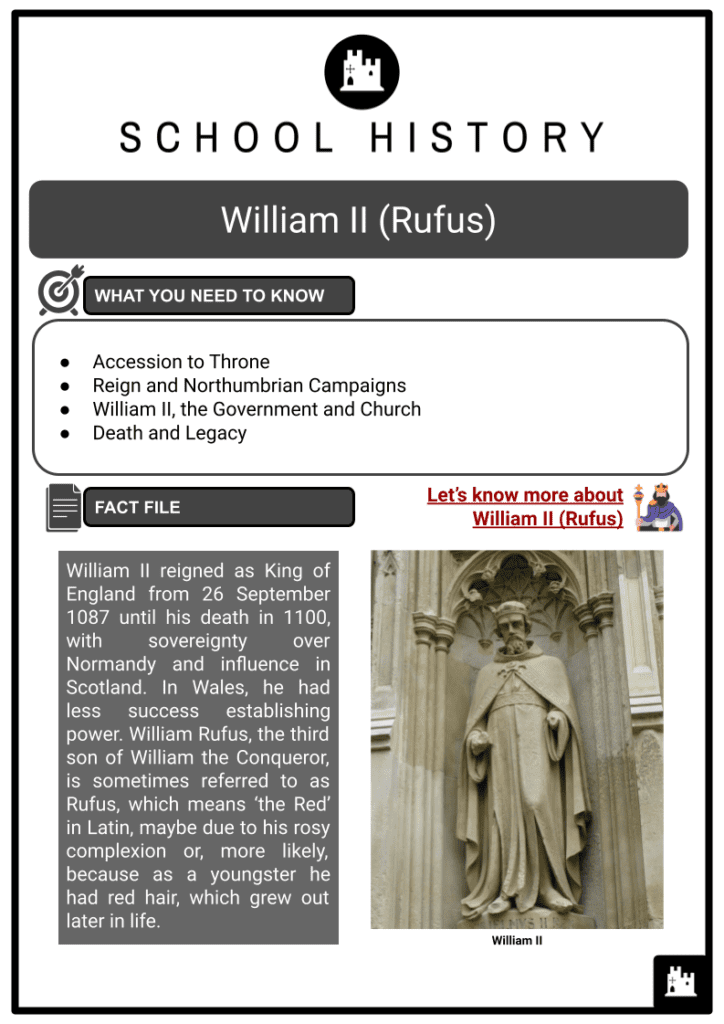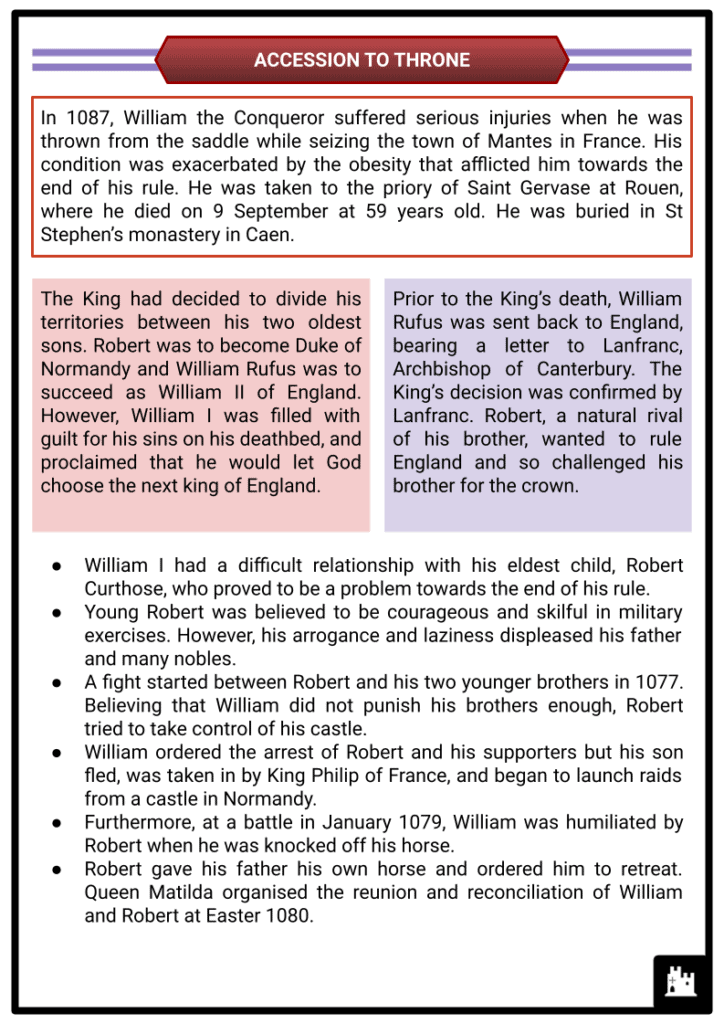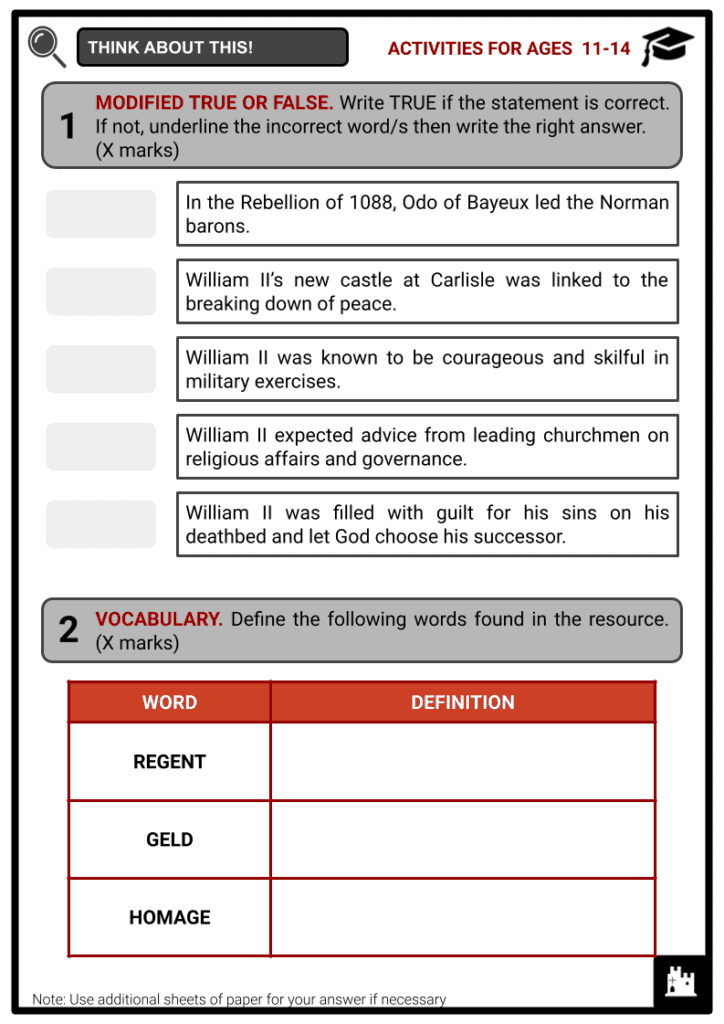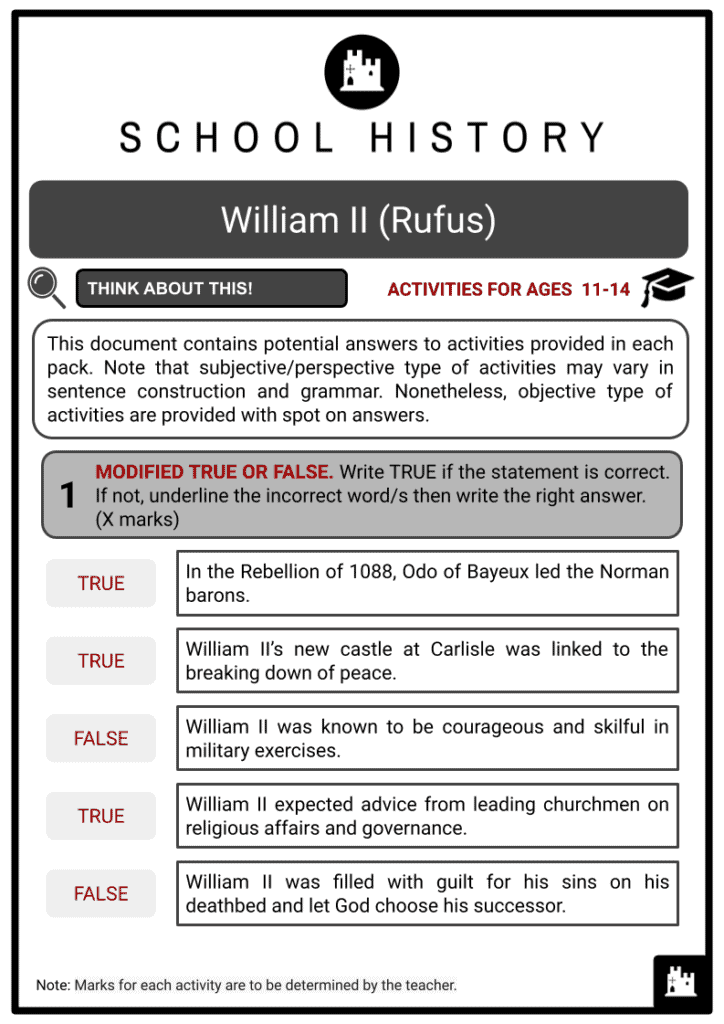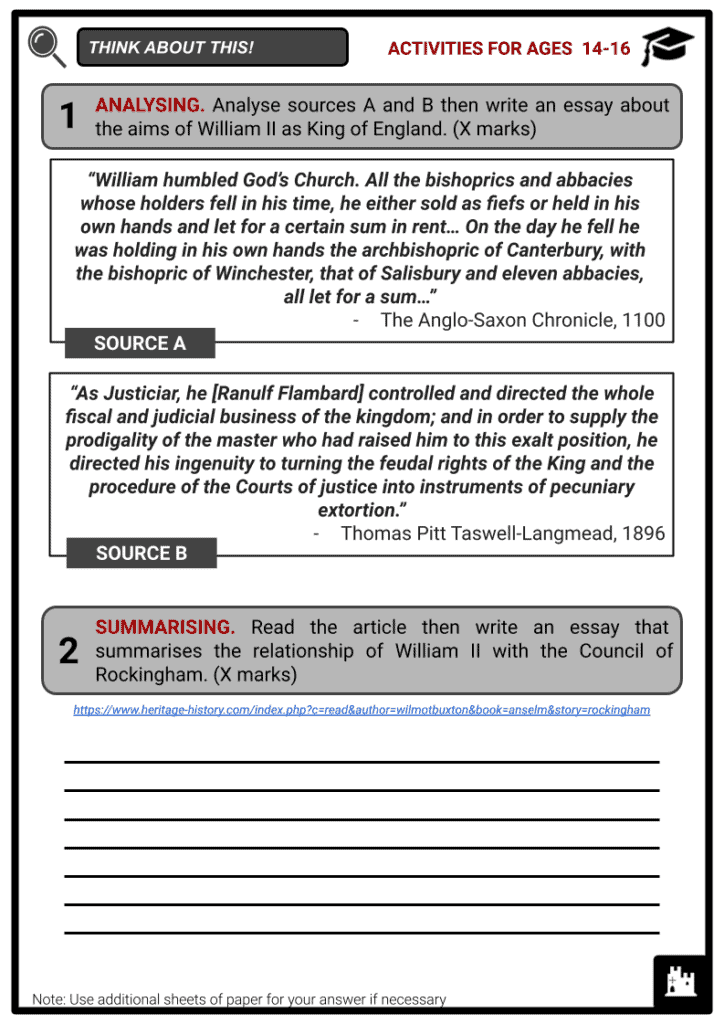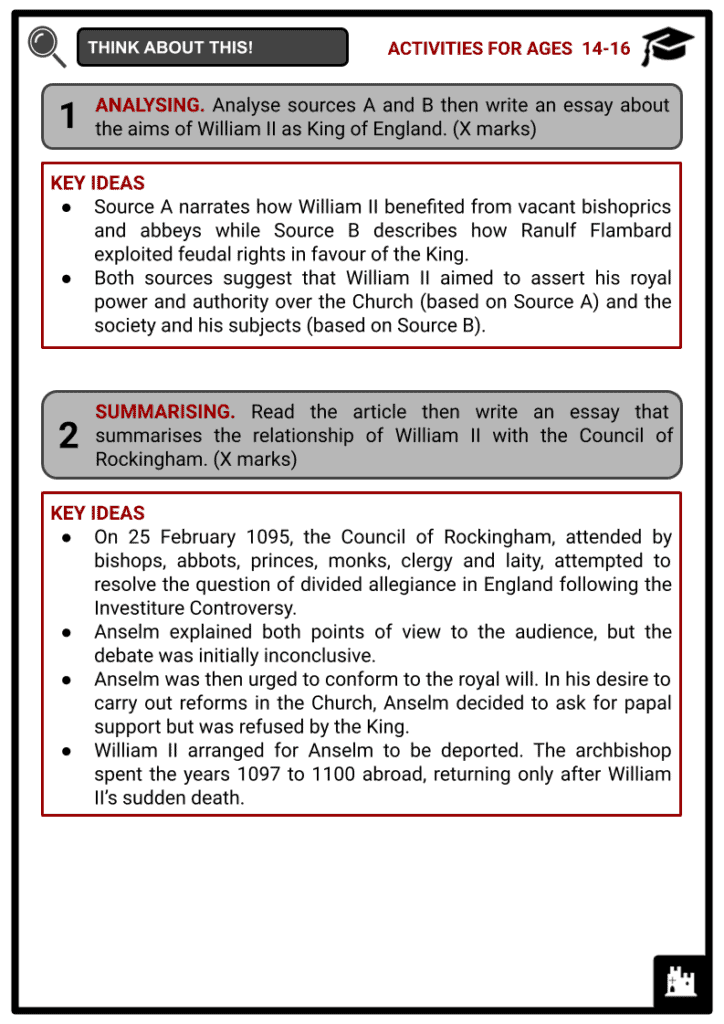William II (Rufus) Worksheets
Do you want to save dozens of hours in time? Get your evenings and weekends back? Be able to teach about William II (Rufus) to your students?
Our worksheet bundle includes a fact file and printable worksheets and student activities. Perfect for both the classroom and homeschooling!
Summary
- Accession to Throne
- Reign and Northumbrian Campaigns
- William II, the Government and Church
- Death and Legacy
Key Facts And Information
Let’s know more about William II (Rufus)!
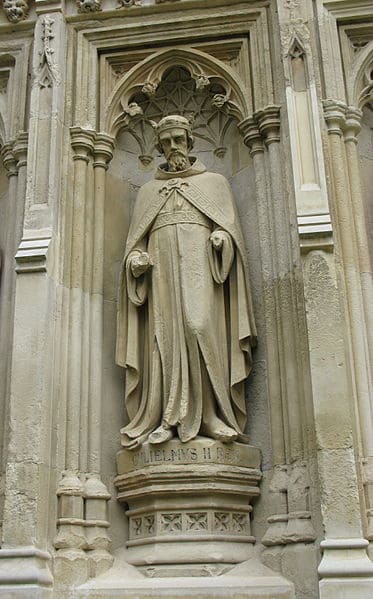
William II reigned as King of England from 26 September 1087 until his death in 1100, with sovereignty over Normandy and influence in Scotland. In Wales, he had less success establishing power. William Rufus, the third son of William the Conqueror, is sometimes referred to as Rufus, which means ‘the Red’ in Latin, maybe due to his rosy complexion or, more likely, because as a youngster he had red hair, which grew out later in life.
ACCESSION TO THRONE
- In 1087, William the Conqueror suffered serious injuries when he was thrown from the saddle while seizing the town of Mantes in France. His condition was exacerbated by the obesity that afflicted him towards the end of his rule. He was taken to the priory of Saint Gervase at Rouen, where he died on 9 September at 59 years old. He was buried in St Stephen’s monastery in Caen.
- The King had decided to divide his territories between his two oldest sons. Robert was to become Duke of Normandy and William Rufus was to succeed as William II of England. However, William I was filled with guilt for his sins on his deathbed, and proclaimed that he would let God choose the next king of England.
- Prior to the King’s death, William Rufus was sent back to England, bearing a letter to Lanfranc, Archbishop of Canterbury. The King’s decision was confirmed by Lanfranc. Robert, a natural rival of his brother, wanted to rule England and so challenged his brother for the crown.
- William I had a difficult relationship with his eldest child, Robert Curthose, who proved to be a problem towards the end of his rule.
- Young Robert was believed to be courageous and skilful in military exercises. However, his arrogance and laziness displeased his father and many nobles.
- A fight started between Robert and his two younger brothers in 1077. Believing that William did not punish his brothers enough, Robert tried to take control of his castle.
- William ordered the arrest of Robert and his supporters but his son fled, was taken in by King Philip of France, and began to launch raids from a castle in Normandy.
- Furthermore, at a battle in January 1079, William was humiliated by Robert when he was knocked off his horse.
- Robert gave his father his own horse and ordered him to retreat. Queen Matilda organised the reunion and reconciliation of William and Robert at Easter 1080.
- Odo of Bayeux was the half-brother of William the Conqueror. For a time, he was second in power after William. When William went back to Normandy, Odo would serve as regent of England. He owned vast estates in 23 counties in England, surpassed only by the king.
- When Lanfranc became Archbishop of Canterbury, he investigated Odo’s alleged fraud of the Church and Crown while he was Earl of Kent in the Trial of Penenden Heath in 1076. Odo was forced to return a number of properties.
- In 1082, Odo was imprisoned for planning a military expedition to Italy. While his estates were confiscated, he remained Bishop of Bayeux. On his deathbed, William ordered the release of all his prisoners.
- Odo was freed and restored to his earldom in Kent when William Rufus succeeded as William II of England.
- Despite being welcomed back to the court at Westminster, he was already planning a rebellion against the new king, supporting Robert’s claim to the English throne. Many Norman barons joined the rebellion in 1088.
- In what became known as the Rebellion of 1088, Odo of Bayeux led the Norman barons in the attempt to unite England and Normandy once more under one ruler. The nobles who held land on both sides of the English Channel feared losing the favour of one ruler or the other, or both, following the division of William the Conqueror’s territories into two parts. This led them to band together to replace the young king with their preferred ruler, Duke Robert.
- Upon his accession, William II assembled a governing clique around him. Archbishop Lanfranc was the most influential in this group, along with the bishops of Durham and Lincoln. The new king had to expand his support beyond his advisers in order to secure his position in England. However, throughout March and April 1088, many of the most powerful barons in England secretly and successfully mobilised against the new king. These included Geoffrey de Montbray, Robert de Mowbray, Roger Bigod and Roger of Montgomery, aided by Count Eustace of Boulogne and the castellans of Leicester and Norwich.
- The barons, who were reported to be the largest baronial landholders in the Domesday Book, commenced a campaign to lay waste the lands of William II and his supporters. In addition, they reinforced their own castles, supplied them with provisions, and waited for the King’s response. Hostilities lasted from three to six months.
- He divided his enemies by promising that those who sided with him would receive as much land and money as they desired.
- He appealed to the English people and vowed to rule England with ‘the best law that had ever been in this land.’
- He attacked the rebels personally and successfully captured the leader of the rebellion, Odo of Bayeux, at Pevensey Castle.
- The reinforcement from Normandy was captured and killed by the English, who were guarding the coast. Duke Robert never showed up to support the rebels.
- Following his capture, Odo of Bayeux was stripped of his belongings and banished to Normandy for life.
- The barons who remained loyal to William II urged the King to be lenient towards the rebel barons.
REIGN AND NORTHUMBRIAN CAMPAIGNS
- During the course of his reign, King Malcolm III of Scotland launched invasions in the northern counties of England numerous times. The Scottish raids stopped when the Treaty of Abernethy 1072 was signed between King Malcolm and William I, in which the Scottish king was given estates in Cumbria in exchange for acknowledging the overlordship of William I.
- In 1091, William II confiscated the lands that belonged to Edgar Aetheling, King Malcolm’s brother-in-law.
- In May of that same year, King Malcolm, who held a general dislike for the Normans, would renew the aggressions in the north of England.
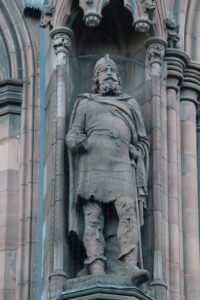
King Malcolm - He besieged Newcastle, which was built by Duke Robert in 1080, in a possible attempt to expand the Scottish border south from the River Tweed to the River Tees.
- William II, who was in Normandy at that time, was threatened by this Scottish advance and decided to return to England with Duke Robert. Learning of the movement of William II’s army, King Malcolm went with his army into Lothian to wait. Unlike in 1072, he was prepared to fight the English army.
- Realising that the odds were against him, King Malcolm agreed to swear fealty. A peace was arranged by Edgar Aetheling and Duke Robert. King Malcolm paid homage to William II, as agreed in the treaty signed in 1091.
- King Malcolm had to acknowledge the overlordship of the English king.
- King Malcolm would retain the 12 villages given to him by William the Conqueror.
- King Malcolm was to be paid an annual sum of £72 of silver to help maintain his household.
- Edgar Aetheling was to return to England.
- William II successfully used diplomacy to prevent a bloody battle.
- However, he realised that, despite the treaty, the borders with Scotland were not clearly defined or secure.
- Hence, he had to keep an eye out in the north of England to prevent similar incidents.
- King Malcolm grew frustrated when the terms of the treaty of 1091 were not honoured, such as the promise of annual payment and the Scottish control of Cumbrian territories. William II’s new castle at Carlisle and the English settlement in the surrounds were linked to the breaking down of peace. King Malcolm’s death led to political chaos in Scotland. The late king’s brother Donald Bane took control and became King of Scotland. William II made controlling the north-west of England his mission after it was revealed how insecure the border was. In 1092 and 1094, he commissioned the Northumbrian campaigns.
- Prepared by the encounter with King Malcolm in 1091, William II took a huge army to the north-west and captured Carlisle. He drove out the local lord, Dolfin, and garrisoned a castle there with his own men. To cultivate the land in the area, he repopulated it with English peasants from the south.
- In addition, he appointed the sheriff and bishop of Durham to supervise the area. This was to secure a defensive position against his north-west frontier. By capturing Carlisle, William took control of Cumberland and Westmorland, which had previously been claimed by the Scots.
- In 1094, William II instructed his men to monitor the activities in the north following King Malcolm’s death, as the new Scottish king, Donald Bane, was not friendly to Normans.
- William II, who was wary of an invasion, never recognised the new king and instead supported King Malcolm’s son, Duncan.
- Donald Bane’s first rule was brief as he was expelled by Duncan, with the assistance of Anglo-Normans in 1094.
- Duncan’s reign was equally short. He was killed at the instigation of his uncle, making way for the restoration of Donald Bane to the Scottish throne.
- William II maintained security over border territories. William II later endorsed another of Malcolm’s sons, Edgar, to become King of Scotland.
- The invasion of Wales by William II in the 1090s was driven by the need to protect England from the Welsh attacks aimed at extending their western border. It had its roots in the events in 1093 succeeding the death of Rhys ap Tewdr, the Welsh leader of Pembrokeshire, at the hands of the Frenchmen during a battle.
- Arnulf, Roger of Montgomery’s son, claimed the land of the late Welsh leader. Consequently, other Norman barons were roused to take key Welsh territory by force. This resulted in the whole of Wales falling to the control of the Normans by the end of 1093. In response, the Welsh claimants attacked the Norman barons in order to get back the region taken from them. The death of Roger of Montgomery in 1094 further inspired Welsh resistance and by early 1095, a rebellion was fully underway. William II failed to respond immediately as he was preoccupied by other serious matters.
- When problems at the Council of Rockingham and with the northern barons were under control, William II travelled to the north of Wales in 1095 but was frustrated by the Welsh guerrilla tactics. He returned to England and planned the next invasion, targeting a more vulnerable region of Wales. The second invasion occurred in 1097, with William II’s forces marching to south Wales through the area of St David’s to secure control of Pembroke. Despite securing Pembroke, the outcome of the invasion was inconclusive. In addition, William II lost considerable resources. He saw no point in going further, hence the north of Wales was still held by Gruffydd ap Cynan. Troubles with the Welsh continued after William II’s second invasion.
WILLIAM II, THE GOVERNMENT AND CHURCH
- Ranulf Flambard was the influential chief minister of William II. Of Norman origin, he became part of Odo’s household. He was introduced to the royal court during the reign of William the Conqueror, rising to the position of keeper of the seal. When William II succeeded to the English throne, he retained his position and went on to become royal chaplain, chief adviser and, for a time, chief justiciar.
- Ranulf raised vast sums by increasing taxes and extorting funds from the barons and the Church. He acted as regent when William II was overseas. He collected revenues for the king’s treasury from the vacant sees and abbeys. He was also involved in justice and writs. Ranulf was resented by the nobility as his policies were considered unfair and oppressive.
- William II was mainly interested in the role of the Church in raising revenue, improving administration, and rewarding loyal followers. In fact, the King used the Church to gain profit.
- William II took geld from religious houses.
- Individuals in the Church were targeted to pay geld in exchange for privileged positions.
- When bishops died, their tenants had to pay the King.
- Vacant sees and abbeys provided regular income.
- William II also expected advice from leading churchmen on religious affairs and governance.
- When William II set off to counter Odo in Kent during the rebellion of the Norman barons in 1088, one of his trusted councillors, William of Saint-Calais, Bishop of Durham, suddenly deserted and shut himself in the Durham Castle. Saint-Calais abandoned the King’s army and refused to provide aid to the King. Even when the rebellion failed, Saint-Calais continued to hold out in Durham and only agreed to come out when he was promised a safe passage to attend a trial.
- The King seized his lands and Saint-Calais was brought for trial on 2 November 1088 at Salisbury.
- Saint-Calais, who was a bishop, refused to be tried in a feudal court and maintained that he had the right to be tried in an ecclesiastical court.
- He also refused to answer the formal accusations. Archbishop Lanfranc argued that Saint-Calais was being tried in regard to his fief to the King as an earl and not his capacity as a bishop.
- When the court adjourned, Saint-Calais was imprisoned at Wilton Abbey until his followers in Durham relinquished the castle.
- Once William II took back control of the castle, Saint-Calais was released and then exiled to Normandy until 1091.
- When Lanfranc died in 1089, the archbishopric of Canterbury remained vacant for many years, which benefited the royal treasury through the appropriation of ecclesiastical revenues. It was not until 1093 that William II, after suffering a serious illness, nominated Anselm to the position.
- Following in his father’s footsteps, William II granted properties to monasteries and supported the completion of Battle Abbey. In addition, the Normans restored the Anglo-Saxon monasteries that were ravaged and assisted in the revival of monastic life.
- Replacement of secular clergy by orders of monks, including the Cluniacs, Augustinians, Cisterniacs and Gilbertines
- Nepotistic appointments of people in abbeys under abbots
- Removal of old, recalcitrant abbots such as in Winchester and Glastonbury
- Building of new monasteries in Norman style and the endowment of monasteries with land
DEATH AND LEGACY
- Robert Curthose decided to join the First Crusade in 1096. In need of funds for this venture, he pledged the Duchy of Normandy to his brother king in return for a payment of 10,000 marks. William II ruled Normandy as regent in his brother’s absence.
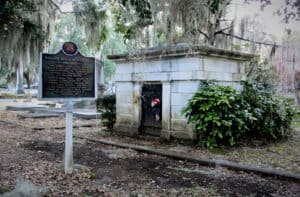
William’s tomb - From 1097 to 1099, William II campaigned in France, securing the northern Maine and attempting to seize Vexin with the aid of Duke William IX of Aquitaine and Robert of Belleme. Duke William IX of Aquitaine persuaded William II to finance his crusading. After the failed campaigns in Vexin, William II returned to England in 1099 to deal with his kingdom’s affairs. Robert returned from the First Crusade and married Sibylla of Conversano in 1099. Henry Beauclerk, the younger brother of William II and Robert, became wary of Robert’s future son as heir.
- On 2 August 1100, William II went hunting with a group of noblemen at Brockenhurst in the New Forest. He was killed by an arrow through the lung that was supposedly fired by one of the knights named Walter Tirel. Tirel fled the scene and his companions did not pursue him. Abandoned by the nobles, the King’s body was later discovered by some locals who transported it to the Winchester Cathedral. William’s remains can be found at Winchester Cathedral, dispersed among the royal funerary boxes positioned on the presbytery screen, either side of the choir. His head appears to have been lost.
- Robert was out of the country at the time while Henry quickly travelled first to Winchester to secure the royal treasury, then to London. On 5 August 1100, Henry was crowned King of England before either archbishop could arrive.
Image Sources
- https://commons.wikimedia.org/wiki/File:William_II_Rufus_sculpture_on_Canterbury_Cathedral.jpg
- https://upload.wikimedia.org/wikipedia/commons/thumb/3/39/Statue_of_King_Malcolm_III%2C_Scottish_National_Portrait_Gallery.jpg/2056px-Statue_of_King_Malcolm_III%2C_Scottish_National_Portrait_Gallery.jpg
- http://encyclopediaofalabama.org/images/m-6312.jpg

